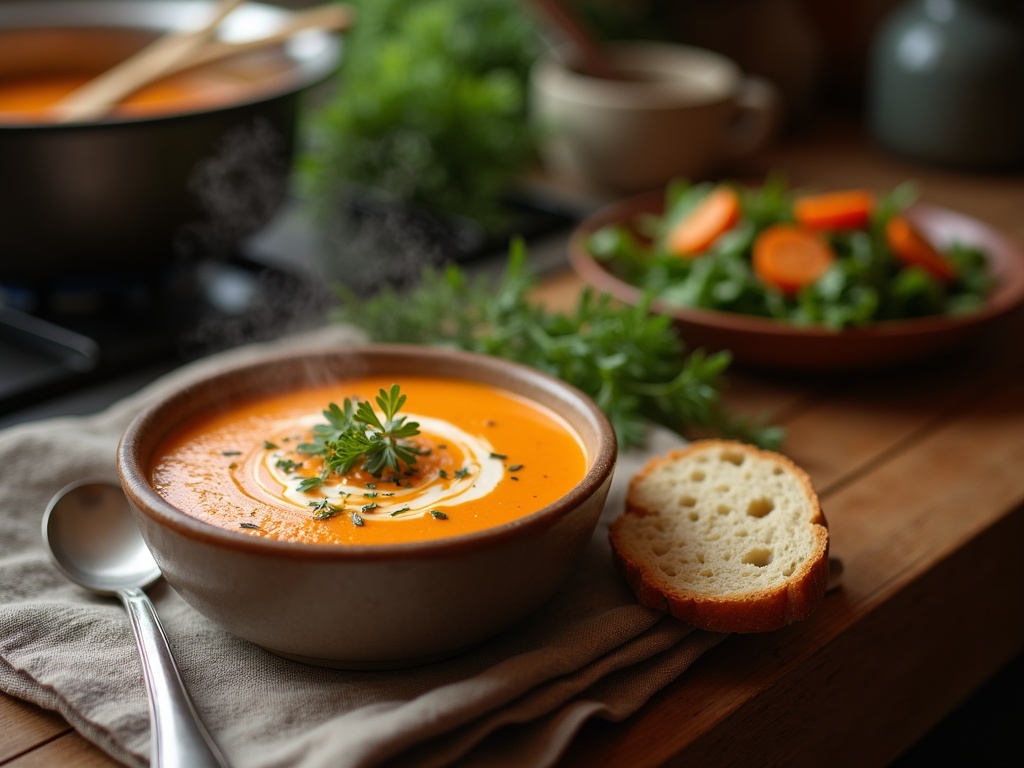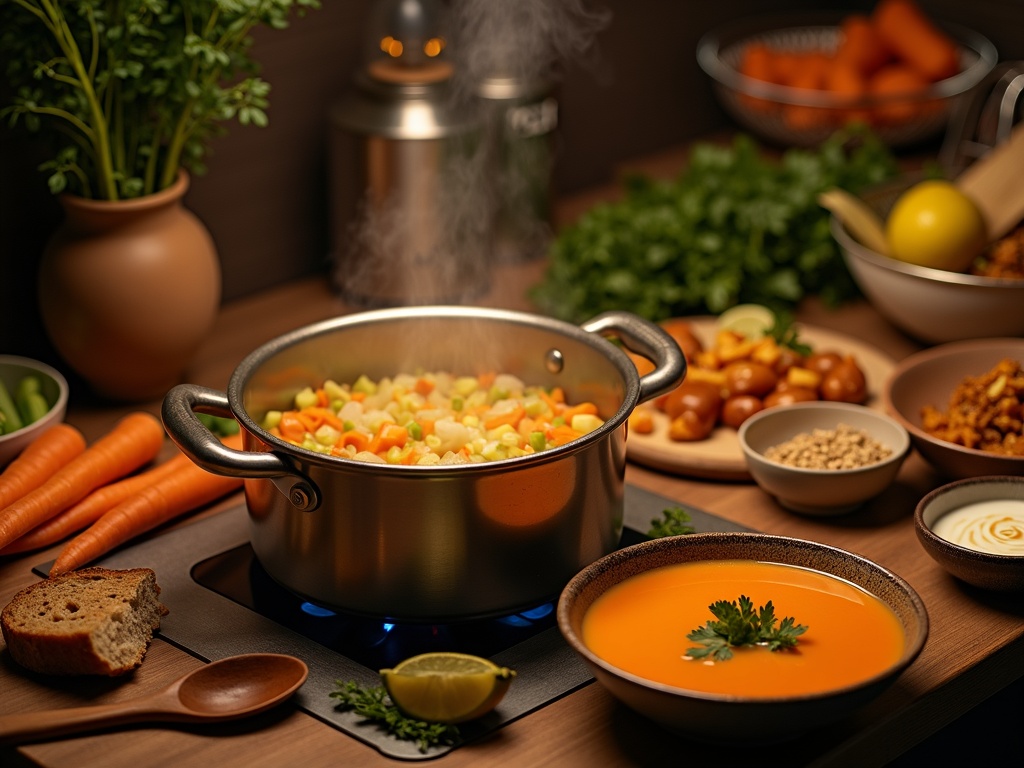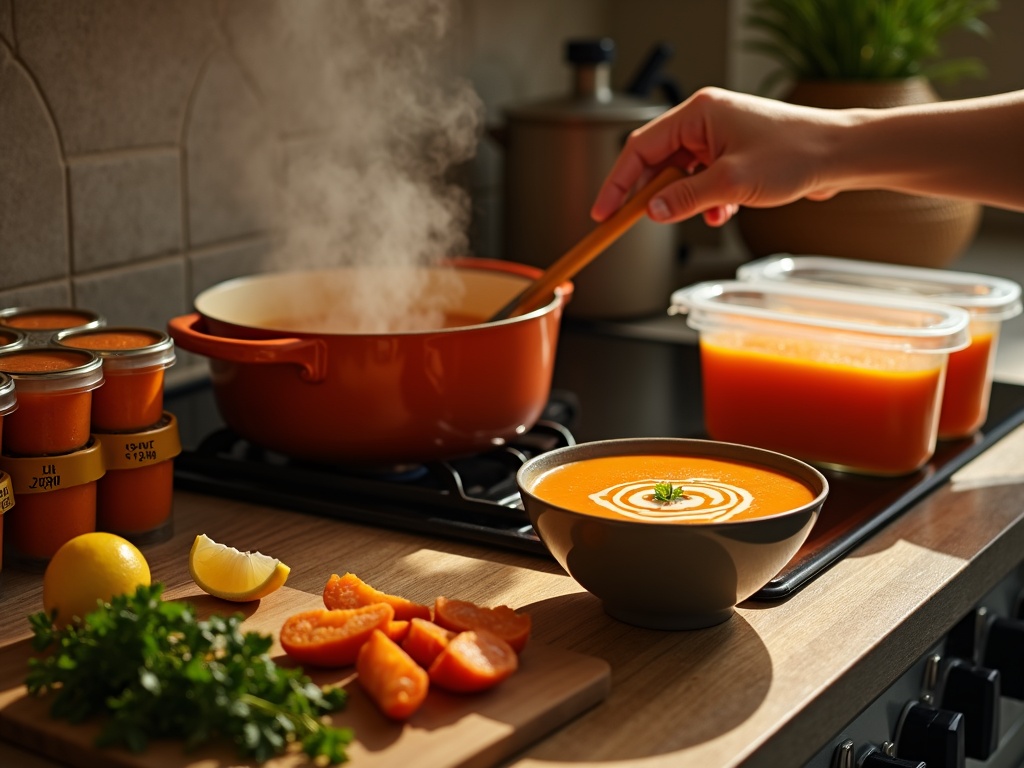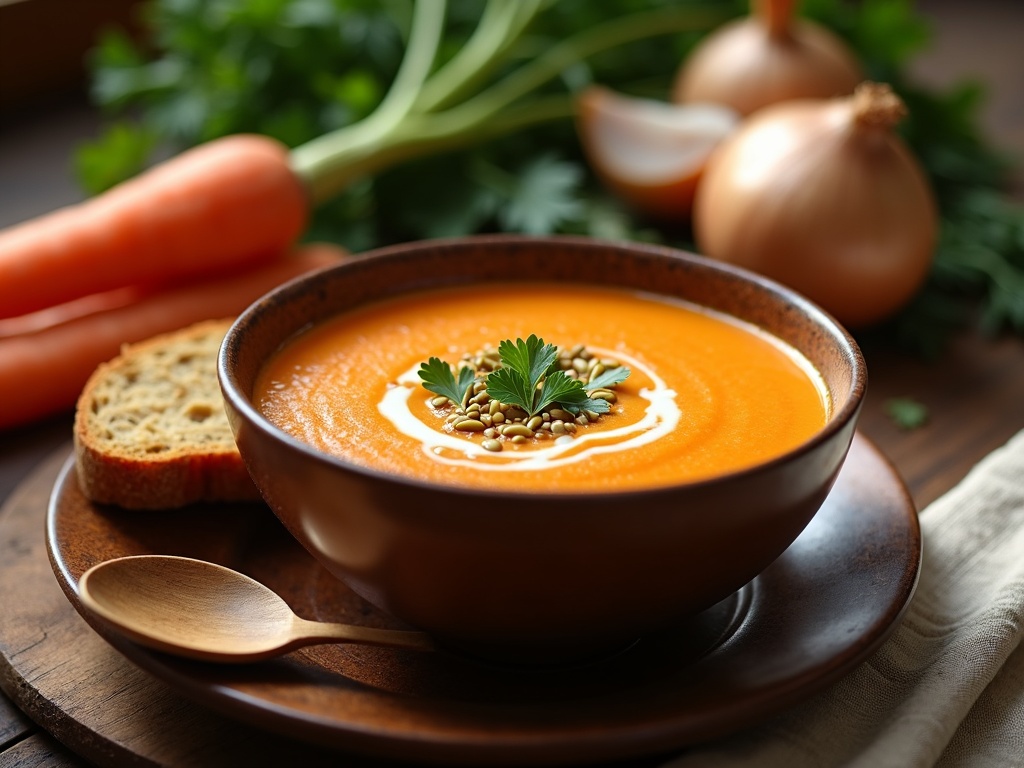Carrot Soup: A Simple and Nutritious Delight
Carrot soup recipe blends natural carrot sweetness with savory flavors, creating a smooth, nutritious dish that’s economical and simple to make.
Find In This Article
Key Takeaways
- The soup comes together in under 45 minutes, with most of the time being hands-off simmering.
- Carrots deliver natural sweetness that can be enhanced through proper cooking techniques like caramelization.
- The recipe is highly adaptable with variations including coconut milk, curry powder, or roasted garlic.
- The texture can vary from rustic to silky smooth depending on your blending method and preferences.
- Carrot soup stores well in the refrigerator for 4 days or can be frozen for up to 3 months, often developing deeper flavors with time.
For more ideas on seasonal dishes and nutritious recipes, you might enjoy exploring this guide on Creamy Carrot Soup from EatingWell.
Why You’ll Love This Comforting Carrot Soup
The perfect balance of sweet and savory flavors makes this carrot soup an instant favorite. I’ve crafted this recipe to highlight the natural sweetness of carrots while adding just enough savory elements to create a balanced, satisfying bowl that pleases even picky eaters.
Quick, Affordable, and Nutritional Powerhouse
This soup comes together in under 45 minutes, making it ideal for busy weeknights when you need something warming but don’t have hours to spend in the kitchen. Most of that time is hands-off simmering, giving you freedom to prepare the rest of your meal or simply relax while delicious aromas fill your kitchen.
The ingredients list won’t break your budget either. Carrots remain one of the most affordable vegetables year-round, and they store beautifully, so you can stock up when they’re on sale. This soup transforms these humble root vegetables into a silky, luxurious dish that tastes far more expensive than its ingredients suggest.
From a nutritional standpoint, this carrot soup delivers impressive benefits. Here’s what makes it so nourishing:
- Beta-carotene: Carrots are packed with this powerful antioxidant that supports eye health and immune function
- Fiber: Each serving provides digestive benefits and helps you feel satisfied longer
- Vitamin K: Supports bone health and blood clotting
- Potassium: Essential for heart health and muscle function
I particularly love how versatile this recipe is. Make a big batch on Sunday, and you’ll have quick, nourishing lunches ready all week. The flavor actually improves after a day in the refrigerator as the ingredients have more time to meld together. For an even heartier meal, pair this vibrant orange soup with crusty bread and a simple side salad.
For those cold winter evenings when you crave something comforting, this soup pairs beautifully with a grilled cheese sandwich. During warmer months, try serving it chilled with a swirl of cream and fresh herbs for a refreshing alternative to heavier dishes like traditional stews.
The smooth, velvety texture makes this soup feel indulgent, even though it’s actually quite light and healthy — perfect for those times when you want something satisfying without heaviness.

What Makes This Soup Special
Carrot soup might sound simple, but this particular recipe stands out with its exceptional qualities. I’ve crafted this soup over years of experimenting in my kitchen, finding the perfect balance of flavors and textures. The result is a bowl of sunshine that manages to be both nourishing and indulgent without the heaviness of traditional cream-based soups.
Distinctive Qualities That Set This Carrot Soup Apart
The velvety texture in this soup comes without a drop of cream. Instead, I use a technique of thoroughly blending the cooked carrots until they transform into a naturally smooth consistency. This creates a luxurious mouthfeel while keeping the soup lighter and dairy-free — perfect for those with lactose intolerance or anyone watching their calorie intake. If you enjoy creamy soups without heavy ingredients, you might also appreciate my gazpacho soup recipe that uses similar techniques.
Carrots bring their natural sweetness to this soup, eliminating the need for added sugars. The key is in the cooking method — slowly sautéing the carrots before adding liquid enhances their inherent sugars through caramelization. I’ve found that adding a small apple to the mix can further complement this sweetness with a hint of tartness, creating a balanced flavor profile that’s never cloying.
Unlike many seasonal dishes, this carrot soup transitions effortlessly throughout the year. In winter, it provides warming comfort alongside a piece of crusty bread, while in summer, it can be served chilled with a swirl of yogurt for a refreshing meal. This adaptability makes it a staple in my recipe collection, much like my versatile homemade chili that works year-round.
The practical benefits of this soup extend to meal prep and storage options. Here’s why this soup is a fantastic make-ahead option:
- Freezes beautifully for up to 3 months without separating or losing texture
- Flavors actually deepen after a day in the refrigerator
- Can be easily scaled up to make large batches for future meals
- Thaws and reheats perfectly without any quality loss
I’ve discovered that blending techniques significantly impact the final texture. Using an immersion blender directly in the pot creates a rustic finish with some texture remaining, while transferring to a high-speed blender results in the silkiest possible consistency. For those who appreciate hearty but smooth soups, you might find my Irish stew recipe offers similar satisfying qualities.
The spice profile can be adjusted based on your preferences or what you have in your pantry. The foundation uses common spices like cumin and coriander, but exotic additions like ground ginger or a pinch of curry powder can transform the character entirely. This adaptability means you’re never locked into one flavor profile, similar to how my butter chicken recipe can be customized to different spice preferences.
The garnishing options for this soup are nearly endless — from herb-infused oils to crunchy toppings like toasted pumpkin seeds or crispy chickpeas. These finishing touches add contrasting textures that elevate the eating experience from a simple soup to a thoughtfully crafted dish, worthy of both weeknight dinners and special occasions.
Everything You’ll Need
One of my favorite things about making homemade soup recipes is their simplicity, and this carrot soup is no exception. I’ve gathered a straightforward list of ingredients that create a deeply satisfying dish without any unnecessary complications.
Main Ingredients
The foundation of any good carrot soup starts with quality vegetables. Here’s what you’ll need to gather before starting:
- 2 pounds fresh carrots – Look for bright orange carrots with firm texture
- 1 large onion – Yellow onions work best for their balanced sweetness
- 4 garlic cloves – Adds depth and complexity to the soup base
- 2 tablespoons olive oil – For sautéing the aromatics
- 4 cups vegetable broth – Creates the liquid base (chicken broth works too)
- 1 teaspoon ground ginger – Adds warmth and complements the carrots
- Salt and pepper to taste – Essential for proper seasoning
Garnishes and Variations
I like to finish my carrot soup with additional elements that enhance both presentation and flavor. Fresh herbs are my go-to garnish, with dill, parsley, or chives being particularly complementary to the sweet carrot base.
For added texture, consider a dollop of Greek yogurt or a swirl of cream on top. A sprinkle of toasted pumpkin seeds or pine nuts can introduce a pleasant crunch that contrasts beautifully with the silky soup.
The beauty of this classic recipe is its adaptability. For a flavor twist, you might experiment with adding a tablespoon of curry powder or a hint of orange zest. During colder months, I sometimes incorporate a touch of cinnamon and nutmeg for a warming effect similar to what you might find in homemade chili recipes.
I find this ingredient list strikes the perfect balance between simplicity and flavor complexity. Though the recipe is basic, the result is a velvety soup with remarkable depth that can stand alone as a light meal or complement heartier main dishes like sandwiches or salads.

How to Make It Step by Step
Making carrot soup is straightforward once you know the proper technique. I’ve broken down this process into simple steps that will help you create a silky, flavorful soup that’s perfect for any season. The key is paying attention to each stage of cooking to develop the deepest flavor possible.
From Raw Ingredients to Creamy Soup
First, I need to prep all my vegetables. I peel and chop about 2 pounds of carrots into roughly equal pieces to ensure even cooking. While working with carrots, I also dice one large onion, mince 2-3 cloves of garlic, and chop a stalk of celery. Having everything ready before starting makes the cooking process much smoother.
Next, I heat 2 tablespoons of olive oil in a large pot over medium heat. Once hot, I add the diced onions and celery, sautéing them for 5-7 minutes until the onions become translucent. This stage is crucial for building the flavor base of the soup. I then add the minced garlic and cook for another 30 seconds until fragrant, being careful not to burn it as garlic can quickly become bitter.
With my aromatics properly sautéed, I add the chopped carrots to the pot and stir to coat them in the flavorful oil. This brief sautéing helps to enhance the natural sweetness of the carrots. After about 2 minutes, I pour in 4-5 cups of vegetable or chicken broth, making sure the carrots are fully submerged.
The simmering stage comes next, which is vital for developing a deep flavor. I bring the mixture to a gentle boil, then reduce the heat and let it simmer uncovered for about 20-30 minutes. The carrots should be tender enough that a fork easily pierces through them. If you enjoy cold soup variations like gazpacho, you’ll appreciate how this hot soup can also be served chilled in summer months.
Once the carrots are completely tender, it’s time for blending. I have a few options here:
- Use an immersion blender directly in the pot (easiest method with less cleanup)
- Transfer the soup in batches to a regular blender (produces the smoothest results)
- Use a food processor if that’s what’s available (works well but may leave small chunks)
Whichever method I choose, I blend until the soup reaches a smooth, velvety consistency. For an extra silky texture, I sometimes pass the blended soup through a fine-mesh strainer, though this step is optional.
The final crucial step involves seasoning to taste. I add salt and freshly ground black pepper, and often a squeeze of fresh lemon juice to brighten the flavors. For extra depth, I might add a teaspoon of ground ginger or a pinch of nutmeg. This is also when I decide if the consistency needs adjusting—adding more broth if it’s too thick or simmering longer if it’s too thin.
Garnishing options are plentiful and can transform a simple homemade soup into something special:
- A swirl of cream
- A sprinkle of fresh herbs like dill or parsley
- Toasted seeds for added texture
For a heartier meal, I sometimes serve it alongside a slice of crusty bread or pair it with a simple stew recipe for a complete comfort food experience.
This carrot soup makes a fantastic starter before moving on to main dishes like butter chicken or pad thai for an international-themed dinner party.

Common Mistakes to Watch For
Cooking delicious soup recipes seems straightforward, but small errors can affect your carrot soup’s flavor and texture. I’ve noticed several common pitfalls that can turn your silky carrot soup into a disappointment.
Recipe Execution Errors
Not cooking carrots until fully tender is perhaps the most frequent mistake. Undercooked carrots won’t blend properly, leaving you with a grainy texture instead of that velvety smooth consistency that makes carrot soup so comforting. I always test by piercing the carrots with a fork – they should slide off easily when ready.
Skipping the sautéing step might save time, but costs flavor. When you sauté carrots with aromatics like onions and garlic, you develop deep caramelization that forms the flavor foundation of your soup. I’ve found just 5-7 minutes of sautéing makes a dramatic difference in the final result.
Adding too much liquid can quickly dilute your carrot soup’s flavor. The vibrant, sweet profile of carrots needs concentration to shine.
- I start with less liquid than I think I need, then gradually add more until reaching the perfect consistency.
- Remember, you can always thin a soup, but fixing an overly watery one is challenging.
Insufficient seasoning leaves carrot soup tasting flat and one-dimensional. Carrots have natural sweetness that needs balancing with salt and acidity.
- I like to use a pinch of salt during cooking,
- Then finish with a splash of lemon juice or vinegar to brighten the flavors.
This simple step elevates the soup from basic to brilliant.
Temperature matters too when serving. While not explicitly on our list, I’ve noticed hearty stews and soups benefit from proper temperature at serving. Carrot soup should be served hot but not scalding to appreciate its subtle flavors.
Rushing the process often leads to disappointment. Unlike quick meals like pad thai or butter chicken, soups need time to develop depth. The good news is that carrot soup actually tastes better the next day, so consider making it ahead.
Want to expand your soup repertoire? Creating homemade chili follows many of the same principles, while Japanese gyoza makes a perfect appetizer before serving your soup masterpiece.
Smart Tips for the Best Results
Making a delicious carrot soup involves more than just following a recipe. The difference between a good soup and an exceptional one often lies in the details. I’ve gathered several practical tips that’ll help you elevate your carrot soup to restaurant quality without complicated techniques.
Selection and Preparation
Starting with the right ingredients makes all the difference when preparing carrot soup. The foundation of exceptional flavor begins before you even turn on the stove.
I always recommend selecting bright orange carrots with fresh, green tops still attached. These visual indicators suggest the carrots are fresh and packed with flavor. Avoid carrots that feel limp or have developed a whitish coating, as they’ve likely lost moisture and sweetness.
Once you’ve chosen perfect carrots, the way you cut them significantly impacts the cooking process. Cutting your carrots into uniform pieces ensures they’ll cook at the same rate, resulting in consistent texture throughout your soup. I aim for pieces about 1/2 inch thick, which balance cooking speed with flavor development. Inconsistent cutting can lead to a soup where some bits are mushy while others remain undercooked.
Before adding your carrots to the pot, consider these preparatory steps:
- Scrub thoroughly rather than peeling if using organic carrots to preserve nutrients
- Remove any green tops completely as they can add bitterness
- For extra sweetness, roast the carrots briefly before adding to the soup
- Cut similar-sized pieces of any additional vegetables like onions or celery
Blending and Seasoning Strategies
The final texture and flavor profile of your carrot soup depends largely on your blending technique and seasoning approach.
An immersion blender works perfectly for soups like this one, allowing you to blend directly in the cooking pot. This simple tool eliminates the hassle and potential mess of transferring hot liquid to a standard blender. I’ve found that an immersion blender also gives you better control over the final texture – you can leave it slightly chunky or blend until perfectly smooth.
When it’s time to season your carrot soup, patience is key. I always start with less seasoning than I think I’ll need, then add more gradually. This methodical approach prevents over-salting or over-spicing your creation. Remember that flavors intensify as soup simmers, so what tastes perfect immediately might become overwhelming after cooking longer.
For truly exceptional carrot soup, consider these seasoning tips:
- Add a small splash of acid (like lemon juice or vinegar) to brighten flavors
- Include a touch of sweetness to enhance the natural sweetness of carrots
- Try warming spices like ginger, cumin, or coriander for depth
- Finish with fresh herbs just before serving
The texture of your carrot soup can be adjusted based on your preference. While working with the immersion blender, if you find your soup too thick, add a little broth to achieve the perfect consistency. Conversely, if it’s too thin, you can simmer it longer to reduce or add a small amount of cooked potato to thicken it naturally.
For those who enjoy experimenting with flavors, consider adding complementary ingredients like a touch of creamy coconut milk or a sprinkle of toasted seeds as a garnish. These simple additions can transform a basic carrot soup into something truly special with minimal extra effort.
Helpful Variations to Try
The beauty of carrot soup lies in its versatility. I’ve experimented with countless variations over the years, each bringing a new dimension to this humble dish. These adaptations can transform your basic carrot soup into something truly special without requiring complicated techniques.
Creative Additions for Every Taste
Adding coconut milk creates a luxuriously creamy texture that balances the natural sweetness of carrots. I typically stir in about a half cup of full-fat coconut milk just before serving for a silky finish. This dairy-free option adds richness while keeping the soup light enough for warmer months, similar to the approach used in refreshing cold soups like gazpacho.
For those who enjoy more complex flavors, try spicing up your soup with curry powder. A tablespoon of quality curry powder introduces warmth and depth that pairs beautifully with carrots’ natural sweetness. This variation creates a soup reminiscent of classic Indian dishes with their complex spice profiles, yet maintains its comforting simplicity.
Including roasted garlic takes your carrot soup to another level entirely. I roast a whole head of garlic until soft and fragrant, then blend it into the soup. The mellow, caramelized flavor complements carrots perfectly without overwhelming the dish. This technique works wonderfully in many hearty soups, just like it does in traditional stews where slow cooking develops rich flavors.
The finishing touch for any soup variation is the perfect topping. Crispy homemade croutons add a delightful textural contrast to the smooth soup. I cut day-old bread into cubes, toss with olive oil and herbs, then bake until golden and crunchy. These crispy bites transform each spoonful, adding texture similar to the crispy elements that make homemade chili so satisfying.
Don’t be afraid to mix and match these variations. A curry-spiced carrot soup with coconut milk and topped with garlic-infused croutons creates a memorable dish that’s far more exciting than standard carrot soup. The key is balancing flavors while letting the natural sweetness of carrots shine through.
Storage and Reheating Guide
Properly storing your carrot soup ensures you can enjoy this vibrant meal beyond the day you make it. I’ve found that good storage practices preserve both flavor and nutritional value, allowing you to enjoy every last drop of your homemade creation.
Refrigeration and Freezing Tips
After your carrot soup has cooled to room temperature, transfer it to airtight containers before refrigeration. The soup stays fresh in the refrigerator for up to 4 days, making it perfect for meal prep or enjoying leftovers throughout the week. I’ve noticed that the flavor often deepens after a day in the fridge, as the ingredients have more time to meld together.
For longer storage, freezing is an excellent option. Here’s how to freeze your carrot soup effectively:
- Use freezer-safe containers with about an inch of headspace to allow for expansion
- Portion the soup into individual servings for easier thawing
- Label containers with the date to track freshness
- Store in the freezer for up to 3 months for optimal quality
I like to freeze smaller portions in silicone muffin trays, then transfer the frozen soup “pucks” to freezer bags – perfect for quick single servings! This method works great with other flavorful soups as well.
When it’s time to enjoy your stored soup, reheating requires a gentle approach to maintain the soup’s texture and flavor profile. The stovetop method typically yields the best results. Simply pour your soup into a pot and heat over medium-low heat, stirring occasionally to ensure even warming. This gradual reheating prevents the soup from scorching at the bottom while preserving its smooth consistency.
During reheating, you might notice your carrot soup has thickened in storage – this is completely normal. Adding a splash of vegetable or chicken broth helps restore the original consistency without diluting the flavor. Start with a small amount (about 2 tablespoons per cup of soup) and adjust to reach your desired thickness.
For frozen soup, I find it’s best to thaw overnight in the refrigerator before reheating. If you’re in a hurry, you can place the frozen container in a warm water bath to loosen the soup from the sides, then transfer to a pot for gentle heating. Unlike heartier options like Irish stew, carrot soup’s delicate flavor requires careful reheating.
The microwave can work in a pinch, but use medium power and stir frequently between 30-second intervals to prevent hot spots that could affect the soup’s texture. Cover with a microwave-safe lid or paper towel to prevent splattering.
One trick I’ve discovered is adding a fresh element when serving reheated soup – a drizzle of cream, fresh herbs, or a squeeze of lemon juice can bring back brightness to older soup. This same technique works wonders when reheating homemade chili or other stored dishes.
For meal prep enthusiasts, consider storing the base carrot soup separately from garnishes like croutons, herbs, or yogurt. Add these fresh elements just before serving to maintain their texture and visual appeal, creating a dish that tastes freshly made every time.


